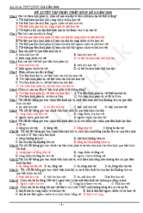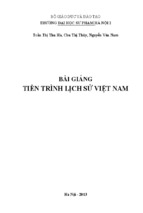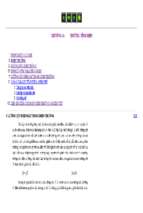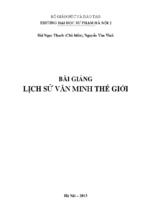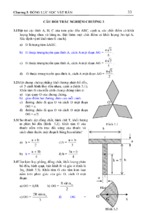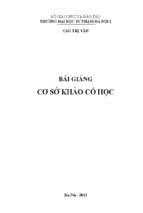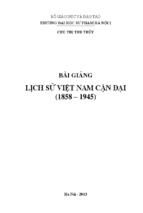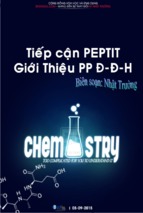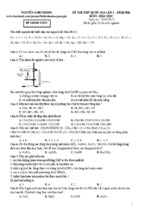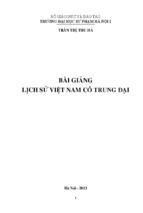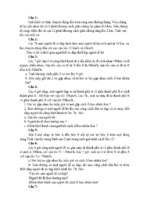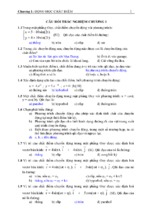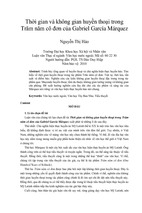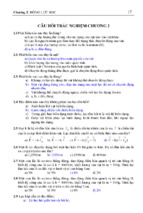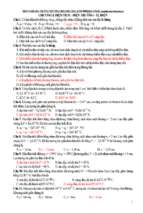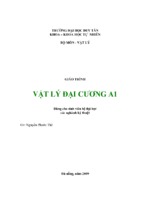James E. Turner
Atoms, Radiation, and
Radiation Protection
1807–2007 Knowledge for Generations
Each generation has its unique needs and aspirations. When Charles Wiley first
opened his small printing shop in lower Manhattan in 1807, it was a generation
of boundless potential searching for an identity. And we were there, helping to
define a new American literary tradition. Over half a century later, in the midst
of the Second Industrial Revolution, it was a generation focused on building
the future. Once again, we were there, supplying the critical scientific, technical,
and engineering knowledge that helped frame the world. Throughout the 20th
Century, and into the new millennium, nations began to reach out beyond their
own borders and a new international community was born. Wiley was there, expanding its operations around the world to enable a global exchange of ideas,
opinions, and know-how.
For 200 years, Wiley has been an integral part of each generation’s journey,
enabling the flow of information and understanding necessary to meet their
needs and fulfill their aspirations. Today, bold new technologies are changing
the way we live and learn. Wiley will be there, providing you the must-have
knowledge you need to imagine new worlds, new possibilities, and new opportunities.
Generations come and go, but you can always count on Wiley to provide you
the knowledge you need, when and where you need it!
William J. Pesce
President and Chief Executive Officer
Peter Booth Wiley
Chairman of the Board
James E. Turner
Atoms, Radiation, and
Radiation Protection
Third, Completely Revised and Enlarged Edition
The Author
J.E. Turner
127 Windham Road
Oak Ridge, TN 37830
USA
All books published by Wiley-VCH are
carefully produced. Nevertheless, authors,
editors, and publisher do not warrant the
information contained in these books,
including this book, to be free of errors.
Readers are advised to keep in mind that
statements, data, illustrations, procedural
details or other items may inadvertently be
inaccurate.
Library of Congress Card No.:
applied for
British Library Cataloguing-in-Publication Data
A catalogue record for this book is available
from the British Library.
Bibliographic information published by
the Deutsche Nationalbibliothek
The Deutsche Nationalbibliothek lists this
publication in the Deutsche
Nationalbibliografie; detailed bibliographic
data are available in the Internet at
.
© 2007 WILEY-VCH Verlag GmbH & Co.
KGaA, Weinheim
All rights reserved (including those of
translation into other languages). No part of
this book may be reproduced in any form – by
photoprinting, microfilm, or any other
means – nor transmitted or translated into a
machine language without written
permission from the publishers. Registered
names, trademarks, etc. used in this book,
even when not specifically marked as such,
are not to be considered unprotected by law.
Typesetting VTEX, Vilnius, Lithuania
Printing betz-druck GmbH, Darmstadt
Binding Litges & Dopf GmbH, Heppenheim
Wiley Bicentennial Logo Richard J. Pacifico
Printed in the Federal Republic of Germany
Printed on acid-free paper
ISBN 978-3-527-40606-7
To Renate
VII
Contents
Preface to the First Edition
XV
Preface to the Second Edition
XVII
Preface to the Third Edition
XIX
1
1.1
1.2
1.3
1.4
1.5
1.6
About Atomic Physics and Radiation
1
Classical Physics
1
Discovery of X Rays
1
Some Important Dates in Atomic and Radiation Physics
Important Dates in Radiation Protection
8
Sources and Levels of Radiation Exposure
11
Suggested Reading
12
2
2.1
2.2
2.3
2.4
2.5
2.6
2.7
2.8
2.9
2.10
2.11
2.12
2.13
2.14
Atomic Structure and Atomic Radiation
15
The Atomic Nature of Matter (ca. 1900)
15
The Rutherford Nuclear Atom
18
Bohr’s Theory of the Hydrogen Atom
19
Semiclassical Mechanics, 1913–1925
25
Quantum Mechanics
28
The Pauli Exclusion Principle
33
Atomic Theory of the Periodic System
34
Molecules
36
Solids and Energy Bands
39
Continuous and Characteristic X Rays
40
Auger Electrons
45
Suggested Reading
47
Problems
48
Answers
53
3
3.1
The Nucleus and Nuclear Radiation
Nuclear Structure
55
55
Atoms, Radiation, and Radiation Protection. James E. Turner
Copyright © 2007 WILEY-VCH Verlag GmbH & Co. KGaA, Weinheim
ISBN: 978-3-527-40606-7
3
Contents
VIII
3.2
3.3
3.4
3.5
3.6
3.7
3.8
3.9
3.10
3.11
Nuclear Binding Energies
58
Alpha Decay
62
65
Beta Decay (β – )
Gamma-Ray Emission
68
Internal Conversion
72
Orbital Electron Capture
72
75
Positron Decay (β + )
Suggested Reading
79
Problems
80
Answers
82
4
4.1
4.2
4.3
4.4
4.5
4.6
4.7
4.8
4.9
Radioactive Decay
83
Activity
83
Exponential Decay
83
Specific Activity
88
Serial Radioactive Decay
89
89
Secular Equilibrium (T1 � T2 )
General Case
91
Transient Equilibrium (T1 � T2 )
91
93
No Equilibrium (T1 < T2 )
Natural Radioactivity
96
Radon and Radon Daughters
97
Suggested Reading
102
Problems
103
Answers
108
5
5.1
5.2
5.3
5.4
5.5
5.6
5.7
5.8
5.9
5.10
5.11
5.12
5.13
5.14
5.15
Interaction of Heavy Charged Particles with Matter
109
Energy-Loss Mechanisms
109
Maximum Energy Transfer in a Single Collision
111
Single-Collision Energy-Loss Spectra
113
Stopping Power
115
Semiclassical Calculation of Stopping Power
116
The Bethe Formula for Stopping Power
120
Mean Excitation Energies
121
Table for Computation of Stopping Powers
123
Stopping Power of Water for Protons
125
Range
126
Slowing-Down Time
131
Limitations of Bethe’s Stopping-Power Formula
132
Suggested Reading
133
Problems
134
Answers
137
Contents
6
6.1
6.2
6.3
6.4
6.5
6.6
6.7
6.8
6.9
6.10
Interaction of Electrons with Matter
139
Energy-Loss Mechanisms
139
Collisional Stopping Power
139
Radiative Stopping Power
144
Radiation Yield
145
Range
147
Slowing-Down Time
148
Examples of Electron Tracks in Water
150
Suggested Reading
155
Problems
155
answers
158
7
7.1
7.2
7.3
7.4
7.5
7.6
7.7
7.8
7.9
7.10
Phenomena Associated with Charged-Particle Tracks
Delta Rays
159
Restricted Stopping Power
159
Linear Energy Transfer (LET)
162
Specific Ionization
163
Energy Straggling
164
Range Straggling
167
Multiple Coulomb Scattering
169
Suggested Reading
170
Problems
171
Answers
172
8
8.1
8.2
8.3
8.4
8.5
8.6
8.7
8.8
8.9
8.10
8.11
8.12
Interaction of Photons with Matter
173
Interaction Mechanisms
173
Photoelectric Effect
174
Energy–Momentum Requirements for Photon Absorption by an
Electron
176
Compton Effect
177
Pair Production
185
Photonuclear Reactions
186
Attenuation Coefficients
187
Energy-Transfer and Energy-Absorption Coefficients
192
Calculation of Energy Absorption and Energy Transfer
197
Suggested Reading
201
Problems
201
Answers
207
9
9.1
9.2
Neutrons, Fission, and Criticality
Introduction
209
Neutron Sources
209
209
159
IX
Contents
X
9.3
9.4
9.5
9.6
9.7
9.8
9.9
9.10
9.11
9.12
9.13
9.14
Classification of Neutrons
214
Interactions with Matter
215
Elastic Scattering
216
Neutron–Proton Scattering Energy-Loss Spectrum
Reactions
223
Energetics of Threshold Reactions
226
Neutron Activation
228
Fission
230
Criticality
232
Suggested Reading
235
Problems
235
Answers
239
Methods of Radiation Detection
241
Ionization in Gases
241
Ionization Current
241
W Values
243
Ionization Pulses
245
Gas-Filled Detectors
247
10.2 Ionization in Semiconductors
252
Band Theory of Solids
252
Semiconductors
255
Semiconductor Junctions
259
Radiation Measuring Devices
262
10.3 Scintillation
266
General
266
Organic Scintillators
267
Inorganic Scintillators
268
10.4 Photographic Film
275
10.5 Thermoluminescence
279
10.6 Other Methods
281
Particle Track Registration
281
Optically Stimulated Luminescence
282
Direct Ion Storage (DIS)
283
Radiophotoluminescence
285
Chemical Dosimeters
285
Calorimetry
286
Cerenkov Detectors
286
10.7 Neutron Detection
287
Slow Neutrons
287
Intermediate and Fast Neutrons
290
10.8 Suggested Reading
296
10.9 Problems
296
10.10 Answers
301
10
10.1
219
Contents
11
11.1
11.2
11.3
11.4
11.5
11.6
11.7
11.8
11.9
11.10
11.11
11.12
11.13
11.14
11.15
11.16
Statistics
303
The Statistical World of Atoms and Radiation
303
Radioactive Disintegration—Exponential Decay
303
Radioactive Disintegration—a Bernoulli Process
304
The Binomial Distribution
307
The Poisson Distribution
311
The Normal Distribution
315
Error and Error Propagation
321
Counting Radioactive Samples
322
Gross Count Rates
322
Net Count Rates
324
Optimum Counting Times
325
Counting Short-Lived Samples
326
Minimum Significant Measured Activity—Type-I Errors
327
Minimum Detectable True Activity—Type-II Errors
331
Criteria for Radiobioassay, HPS Nl3.30-1996
335
Instrument Response
337
Energy Resolution
337
Dead Time
339
Monte Carlo Simulation of Radiation Transport
342
Suggested Reading
348
Problems
349
Answers
359
Radiation Dosimetry
361
Introduction
361
Quantities and Units
362
Exposure
362
Absorbed Dose
362
Dose Equivalent
363
12.3 Measurement of Exposure
365
Free-Air Ionization Chamber
365
The Air-Wall Chamber
367
12.4 Measurement of Absorbed Dose
368
12.5 Measurement of X- and Gamma-Ray Dose
370
12.6 Neutron Dosimetry
371
12.7 Dose Measurements for Charged-Particle Beams
376
12.8 Determination of LET
377
12.9 Dose Calculations
379
Alpha and Low-Energy Beta Emitters Distributed in Tissue
Charged-Particle Beams
380
Point Source of Gamma Rays
381
Neutrons
383
12.10 Other Dosimetric Concepts and Quantities
387
12
12.1
12.2
379
XI
Contents
XII
Kerma
387
Microdosimetry
387
Specific Energy
388
Lineal Energy
388
12.11 Suggested Reading
389
12.12 Problems
390
12.13 Answers
398
13.15
13.16
13.17
Chemical and Biological Effects of Radiation
399
Time Frame for Radiation Effects
399
Physical and Prechemical Chances in Irradiated Water
399
Chemical Stage
401
Examples of Calculated Charged-Particle Tracks in Water
402
Chemical Yields in Water
404
Biological Effects
408
Sources of Human Data
411
The Life Span Study
411
Medical Radiation
413
Radium-Dial Painters
415
Uranium Miners
416
Accidents
418
The Acute Radiation Syndrome
419
Delayed Somatic Effects
421
Cancer
421
Life Shortening
423
Cataracts
423
Irradiation of Mammalian Embryo and Fetus
424
Genetic Effects
424
Radiation Biology
429
Dose–Response Relationships
430
Factors Affecting Dose Response
435
Relative Biological Effectiveness
435
Dose Rate
438
Oxygen Enhancement Ratio
439
Chemical Modifiers
439
Dose Fractionation and Radiotherapy
440
Suggested Reading
441
Problems
442
Answers
447
14
14.1
14.2
Radiation-Protection Criteria and Exposure Limits
449
Objective of Radiation Protection
449
Elements of Radiation-Protection Programs
449
13
13.1
13.2
13.3
13.4
13.5
13.6
13.7
13.8
13.9
13.10
13.11
13.12
13.13
13.14
Contents
14.3
14.4
14.5
14.6
14.7
14.8
14.9
14.10
14.11
14.12
14.13
The NCRP and ICRP
451
NCRP/ICRP Dosimetric Quantities
452
Equivalent Dose
452
Effective Dose
453
Committed Equivalent Dose
455
Committed Effective Dose
455
Collective Quantities
455
Limits on Intake
456
Risk Estimates for Radiation Protection
457
Current Exposure Limits of the NCRP and ICRP
458
Occupational Limits
458
Nonoccupational Limits
460
Negligible Individual Dose
460
Exposure of Individuals Under 18 Years of Age
461
Occupational Limits in the Dose-Equivalent System
463
The “2007 ICRP Recommendations”
465
ICRU Operational Quantities
466
Probability of Causation
468
Suggested Reading
469
Problems
470
Answers
473
15.4
15.5
15.6
15.7
15.8
External Radiation Protection
475
Distance, Time, and Shielding
475
Gamma-Ray Shielding
476
Shielding in X-Ray Installations
482
Design of Primary Protective Barrier
485
Design of Secondary Protective Barrier
491
NCRP Report No. 147
494
Protection from Beta Radiation
495
Neutron Shielding
497
Suggested Reading
500
Problems
501
Answers
509
16
16.1
16.2
16.3
16.4
16.5
16.6
16.7
Internal Dosimetry and Radiation Protection
511
Objectives
511
ICRP Publication 89
512
Methodology
515
ICRP-30 Dosimetric Model for the Respiratory System
517
ICRP-66 Human Respiratory Tract Model
520
ICRP-30 Dosimetric Model for the Gastrointestinal Tract
523
Organ Activities as Functions of Time
524
15
15.1
15.2
15.3
XIII
Contents
XIV
16.8
16.9
16.10
16.11
16.12
16.13
16.14
16.15
Specific Absorbed Fraction, Specific Effective Energy, and
Committed Quantities
530
Number of Transformations in Source Organs over 50 Y
534
Dosimetric Model for Bone
537
ICRP-30 Dosimetric Model for Submersion in a Radioactive Gas
Cloud
538
Selected ICRP-30 Metabolic Data for Reference Man
540
Suggested Reading
543
Problems
544
Answers
550
Appendices
551
A
Physical Constants
B
Units and Conversion Factors
C
Some Basic Formulas of Physics (MKS and CCS Units)
555
Classical Mechanics
555
Relativistic Mechanics (units same as in classical mechanics)
Electromagnetic Theory
556
Quantum Mechanics
556
D
Selected Data on Nuclides
E
Statistical Derivations
569
Binomial Distribution
569
Mean
569
Standard Deviation
569
Poisson Distribution
570
Normalization
571
Mean
571
Standard Deviation
572
Normal Distribution
572
Error Propagation
573
Index
575
553
557
555
XV
Preface to the First Edition
Atoms, Radiation, and Radiation Protection was written from material developed
by the author over a number of years of teaching courses in the Oak Ridge Resident Graduate Program of the University of Tennessee’s Evening School. The
courses dealt with introductory health physics, preparation for the American Board
of Health Physics certification examinations, and related specialized subjects such
as microdosimetry and the application of Monte Carlo techniques to radiation protection. As the title of the book is meant to imply, atomic and nuclear physics and
the interaction of ionizing radiation with matter are central themes. These subjects
are presented in their own right at the level of basic physics, and the discussions are
developed further into the areas of applied radiation protection. Radiation dosimetry, instrumentation, and external and internal radiation protection are extensively
treated. The chemical and biological effects of radiation are not dealt with at length,
but are presented in a summary chapter preceding the discussion of radiationprotection criteria and standards. Non-ionizing radiation is not included. The book
is written at the senior or beginning graduate level as a text for a one-year course
in a curriculum of physics, nuclear engineering, environmental engineering, or an
allied discipline. A large number of examples are worked in the text. The traditional
units of radiation dosimetry are used in much of the book; SI units are employed in
discussing newer subjects, such as ICRP Publications 26 and 30. SI abbreviations
are used throughout. With the inclusion of formulas, tables, and specific physical
data, Atoms, Radiation, and Radiation Protection is also intended as a reference for
professionals in radiation protection.
I have tried to include some important material not readily available in textbooks
on radiation protection. For example, the description of the electronic structure
of isolated atoms, fundamental to understanding so much of radiation physics,
is further developed to explain the basic physics of “collective” electron behavior
in semiconductors and their special properties as radiation detectors. In another
area, under active research today, the details of charged-particle tracks in water are
described from the time of the initial physical, energy-depositing events through
the subsequent chemical changes that take place within a track. Such concepts are
basic for relating the biological effects of radiation to particle-track structure.
I am indebted to my students and a number of colleagues and organizations,
who contributed substantially to this book. Many individual contributions are acAtoms, Radiation, and Radiation Protection. James E. Turner
Copyright © 2007 WILEY-VCH Verlag GmbH & Co. KGaA, Weinheim
ISBN: 978-3-527-40606-7
XVI
Preface to the First Edition
knowledged in figure captions. In addition, I would like to thank J. H. Corbin and
W. N. Drewery of Martin Marietta Energy Systems, Inc.; Joseph D. Eddleman of
Pulcir, Inc.; Michael D. Shepherd of Eberline; and Morgan Cox of Victoreen for
their interest and help. I am especially indebted to my former teacher, Myron F.
Fair, from whom I learned many of the things found in this book in countless
discussions since we first met at Vanderbilt University in 1952.
It has been a pleasure to work with the professional staff of Pergamon Press, to
whom I express my gratitude for their untiring patience and efforts throughout the
production of this volume.
The last, but greatest, thanks are reserved for my wife, Renate, to whom this
book is dedicated. She typed the entire manuscript and the correspondence that
went with it. Her constant encouragement, support, and work made the book a
reality.
Oak Ridge, Tennessee
November 20, 1985
James E. Turner
XVII
Preface to the Second Edition
The second edition of Atoms, Radiation, and Radiation Protection has several important new features. SI units are employed throughout, the older units being defined but used sparingly. There are two new chapters. One is on statistics for health
physics. It starts with the description of radioactive decay as a Bernoulli process and
treats sample counting, propagation of error, limits of detection, type-I and type-II
errors, instrument response, and Monte Carlo radiation-transport computations.
The other new chapter resulted from the addition of material on environmental radioactivity, particularly concerning radon and radon daughters (not much in vogue
when the first edition was prepared in the early 1980s). New material has also been
added to several earlier chapters: a derivation of the stopping-power formula for
heavy charged particles in the impulse approximation, a more detailed discussion
of beta-particle track structure and penetration in matter, and a fuller description
of the various interaction coefficients for photons. The chapter on chemical and biological effects of radiation from the first edition has been considerably expanded.
New material is also included there, and the earlier topics are generally dealt with
in greater depth than before (e.g., the discussion of data on human exposures). The
radiation exposure limits from ICRP Publications 60 and 61 and NCRP Report No.
116 are presented and discussed. Annotated bibliographies have been added at the
end of each chapter. A number of new worked examples are presented in the text,
and additional problems are included at the ends of the chapters. These have been
tested in the classroom since the 1986 first edition. Answers are now provided to
about half of the problems. In summary, in its new edition, Atoms, Radiation, and
Radiation Protection has been updated and expanded both in breadth and in depth
of coverage. Most of the new material is written at a somewhat more advanced level
than the original.
I am very fortunate in having students, colleagues, and teachers who care about
the subjects in this book and who have shared their enthusiasm, knowledge, and
talents. I would like to thank especially the following persons for help I have received in many ways: James S. Bogard, Wesley E. Bolch, Allen B. Brodsky, Darryl J.
Downing, R. J. Michael Fry, Robert N. Hamm, Jerry B. Hunt, Patrick J. Papin, Herwig G. Paretzke, Tony A. Rhea, Robert W. Wood, Harvel A. Wright, and Jacquelyn
Yanch. The continuing help and encouragement of my wife, Renate, are gratefully
acknowledged. I would also like to thank the staff of John Wiley & Sons, with whom
Atoms, Radiation, and Radiation Protection. James E. Turner
Copyright © 2007 WILEY-VCH Verlag GmbH & Co. KGaA, Weinheim
ISBN: 978-3-527-40606-7
XVIII
Preface to the Second Edition
I have enjoyed working, particularly Gregory T. Franklin, John P. Falcone, and Angioline Loredo.
Oak Ridge, Tennessee
January 15, 1995
James E. Turner
XIX
Preface to the Third Edition
Since the preparation of the second edition (1995) of Atoms, Radiation, and Radiation Protection, many important developments have taken place that affect the
profession of radiological health protection. The International Commission on Radiological Protection (ICRP) has issued new documents in a number of areas that
are addressed in this third edition. These include updated and greatly expanded
anatomical and physiological data that replace “reference man” and revised models of the human respiratory tract, alimentary tract, and skeleton. At this writing,
the Main Commission has just adopted the Recommendations 2007, thus laying
the foundation and framework for continuing work from an expanded contemporary agenda into future practice. Dose constraints, dose limits, and optimization are
given roles as core concepts. Medical exposures, exclusion levels, and radiation protection of nonhuman species are encompassed. The National Council on Radiation
Protection and Measurements (NCRP) in the United States has introduced new
limiting criteria and provided extensive data for the design of structural shielding for medical X-ray imaging facilities. Kerma replaces the traditional exposure as
the shielding design parameter. The Council also completed its shielding report
for megavoltage X- and gamma-ray radiotherapy installations. In other areas, the
National Research Council’s Committee on the Biological Effects of Ionizing Radiation published the BEIR VI and BEIR VII Reports, respectively dealing with indoor
radon and with health risks from low levels of radiation. The very successful completion of the DS02 dosimetry system and the continuing Life Span Study of the
Japanese atomic-bomb survivors represent additional major accomplishments discussed here.
Rapid advances since the last edition of this text have been made in instrumentation for the detection, monitoring, and measurement of ionizing radiation. These
have been driven by improvements in computers, computer interfacing, and, in
no small part, by heightened concern for nuclear safeguards and home security.
Chapter 10 on Methods of Radiation Detection required extensive revision and the
addition of considerable new material.
As in the previous edition, the primary regulatory criteria used here for discussions and working problems follow those given in ICRP Publication 60 with limits
on effective dose to an individual. These recommendations are the principal ones
employed throughout the world today, except in the United States. The ICRP-60
Atoms, Radiation, and Radiation Protection. James E. Turner
Copyright © 2007 WILEY-VCH Verlag GmbH & Co. KGaA, Weinheim
ISBN: 978-3-527-40606-7
XX
Preface to the Third Edition
limits for individual effective dose, with which current NCRP recommendations
are consistent, are also generally encompassed within the new ICRP Recommendations 2007. The earlier version of the protection system, limiting effective dose
equivalent to an individual, is generally employed in the U.S. Some discussion and
comparison of the two systems, which both adhere to the ALARA principle (“as
low as reasonable achievable”), has been added in the present text. As a practical
matter, both maintain a comparable degree of protection in operating experience.
It will be some time until the new model revisions and other recent work of the
ICRP become fully integrated into unified general protocols for internal dosimetry.
While there has been partial updating at this time, much of the formalism of ICRP
Publication 30 remains in current use at the operating levels of health physics in
many places. After some thought, this formalism continues to be the primary focus
in Chapter 16 on Internal Dosimetry and Radiation Protection. To a considerable
extent, the newer ICRP Publications follow the established format. They are described here in the text where appropriate, and their relationships to Publication
30 are discussed.
As evident from acknowledgements made throughout the book, I am indebted
to many sources for material used in this third edition. I would like to express
my gratitude particularly to the following persons for help during its preparation:
M. I. Al-Jarallah, James S. Bogard, Rhonda S. Bogard, Wesley. E. Bolch, Roger J.
Cloutier, Darryl J. Downing, Keith F. Eckerman, Joseph D. Eddlemon, Paul W.
Frame, Peter Jacob, Cynthia G. Jones, Herwig G. Paretzke, Charles A. Potter, Robert
C. Ricks, Joseph Rotunda, Richard E. Toohey, and Vaclav Vylet. Their interest and
contributions are much appreciated. I would also like to thank the staff of John Wiley & Sons, particularly Esther Dörring, Anja Tschörtner, and Dagmar Kleemann,
for their patience, understanding, and superb work during the production of this
volume.
Oak Ridge, Tennessee
March 21, 2007
James E. Turner
1
1
About Atomic Physics and Radiation
1.1
Classical Physics
As the nineteenth century drew to a close, man’s physical understanding of the
world appeared to rest on firm foundations. Newton’s three laws accounted for the
motion of objects as they exerted forces on one another, exchanging energy and
momentum. The movements of the moon, planets, and other celestial bodies were
explained by Newton’s gravitation law. Classical mechanics was then over 200 years
old, and experience showed that it worked well.
Early in the century Dalton’s ideas revealed the atomic nature of matter, and
in the 1860s Mendeleev proposed the periodic system of the chemical elements.
The seemingly endless variety of matter in the world was reduced conceptually to
the existence of a finite number of chemical elements, each consisting of identical
smallest units, called atoms. Each element emitted and absorbed its own characteristic light, which could be analyzed in a spectrometer as a precise signature of the
element.
Maxwell proposed a set of differential equations that explained known electric
and magnetic phenomena and also predicted that an accelerated electric charge
would radiate energy. In 1888 such radiated electromagnetic waves were generated
and detected by Hertz, beautifully confirming Maxwell’s theory.
In short, near the end of the nineteenth century man’s insight into the nature of
space, time, matter, and energy seemed to be fundamentally correct. While much
exciting research in physics continued, the basic laws of the universe were generally considered to be known. Not many voices forecasted the complete upheaval
in physics that would transform our perception of the universe into something
undreamed of as the twentieth century began to unfold.
1.2
Discovery of X Rays
The totally unexpected discovery of X rays by Roentgen on November 8, 1895 in
Wuerzburg, Germany, is a convenient point to regard as marking the beginning of
Atoms, Radiation, and Radiation Protection. James E. Turner
Copyright © 2007 WILEY-VCH Verlag GmbH & Co. KGaA, Weinheim
ISBN: 978-3-527-40606-7
- Xem thêm -


